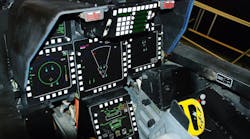By John Keller
EL SEGUNDO, Calif. — Super-high-speed free-space laser communications links are to be the technological cornerstone of a future military satellite communications constellation that is to increase the communications capabilities of deployed military forces by "an order of magnitude."
The new Transformational Satellite Communications system — better known as TSAT — will feature 10-gigabit-per-second laser cross links between satellites, and between satellites and high-altitude manned and unmanned aircraft.
The eight-satellite TSAT constellation is to be fully operational in 2016, says Christine Anderson, director of the U.S. Department of Defense (DOD) Military Satellite Communications (MILSATCOM) Joint Program Office at Los Angeles Air Force Base in El Segundo, Calif.
Free-space lasers cannot operate reliably through the low-Earth atmosphere because of clouds, precipitation, dust, and other obscurants, Anderson explains. For that reason, TSAT's data links to ground stations will be extremely high frequency (EHF) RF links able to move data as quickly as 2 gigabits per second.
TSAT's optical cross links will be solid-state lasers with 1-to-10-watt amplifiers, with digitally reprogrammable routers, explains Dr. Troy E. Meink, manager of the Transformation Communications Military Satellite Communications program in the MILSATCOM Joint Program Office.
"We want routers as flexible as possible on orbit," Meink says, explaining that the TSAT routers will make broad use of the latest digital signal processors and field programmable gate arrays.
Two industry teams, led by Lockheed Martin Space Systems Co. in Sunnyvale, Calif., and Boeing Satellite Systems in El Segundo, Calif., are designing potential TSAT spacecraft. DOD leaders will choose a TSAT satellite contractor in 2006.
The contractor teams are concentrating on developing TSAT digital processors, laser communications, and advanced antennas.
The final constellation is to have five fully capable satellites in geosynchronous orbits, and three lighter, less-capable satellites called the Advanced Polar System (APS) to help cover potential communications gaps in Earth's polar regions.
DOD officials anticipate a substantial speedup of TSAT development next year. This year the program operates with a $335.4 million budget, yet next year DOD officials are asking Congress to more than double that amount to $774.8 million.
The TSAT and APS satellites, as well as their companion Earth-based million operations system, make up a program called MILSATCOM Transformational Communications, or TCM. The overall goal of this program is to provide deployed military forces the same communications bandwidth as those who are tied directly into the Global Information Grid optical fiber network.
"TSATs are nodes on a network, or routers in space," Anderson explains. Rather than today's satellite-based circuit-switched communications systems, which are essentially point-to-point communications systems, the TCM will be a fast Internet-like communications network able to move large image files in a fraction of the time of today's satellites.
The TSAT system will use high-speed versions of the latest Internet Protocol, called Internet Protocol Version 6, or IPv6, which is sometimes called the Next Generation Internet Protocol, Anderson says.
Today's Military Strategic, Tactical & Relay II (MILSTAR II) satellite communications system, for example, takes two minutes to transmit a 24-megabyte 8-by-10-inch image, while the TSAT system should be able to do that in less than a second.
A 1-gigabyte image from a space-based radar satellite would take 88 minutes to move over MILSTAR II, while TSAT would take less than a second. In addition, TSAT will enable as many as 1,500 combat vehicles on the move to move data, while MILSTAR II has no on-the-move capability, Anderson says.
DOD leaders are sponsoring research to help develop TSAT lasers with the 4,123-pound Geosynchronous Lightweight Technology Experiment satellite, or GeoLITE, which launched in May 2001. The GeoLITE satellite, built by TRW before Northrop Grumman Corp. acquired that company, is a technology demonstration for the U.S. National Reconnaissance Office to test laser communications.
Scientists at the Massachusetts Institute of Technology's Lincoln Laboratory in Lexington, Mass., developed the GeoLITE's laser-communications payload. The satellite is in geostationary orbit 22,300 miles above the equator, and is expected to operate through 2010.


